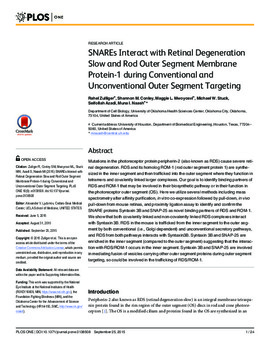| dc.contributor.author | Rahel Zulliger | |
| dc.contributor.author | Shannon M. Conley | |
| dc.contributor.author | Maggie L. Mwoyosvi | |
| dc.contributor.author | Michael W. Stuck | |
| dc.contributor.author | Seifollah Azadi | |
| dc.contributor.author | Muna I. Naash | |
| dc.date.accessioned | 2017-03-05T22:55:16Z | |
| dc.date.available | 2017-03-05T22:55:16Z | |
| dc.date.issued | 2015-09-25 | |
| dc.identifier.citation | Zulliger R, Conley SM, Mwoyosvi ML, Stuck MW, Azadi S, Naash MI (2015) SNAREs Interact with Retinal Degeneration Slow and Rod Outer Segment Membrane Protein-1 during Conventional and Unconventional Outer Segment Targeting. PLoS ONE 10(9): e0138508. doi:10.1371/journal.pone.0138508 | en_US |
| dc.identifier.uri | https://hdl.handle.net/11244/49274 | |
| dc.description | The authors would like to thank Mr. Marc Banworth, Mr. Justin Burnett, and Ms. Jamie Watson for their technical assistance, Drs. Muayyad Al-Ubaidi and David Sherry for their comments on the manuscript, and Drs. Roger Janz, Roderick McInnes, Neeraj Agarwal, Vadim Arshavsky, Robert Molday and Anand Swaroop for the provision of reagents as indicated in the text. | en_US |
| dc.description | | en_US |
| dc.description.abstract | Mutations in the photoreceptor protein peripherin-2 (also known as RDS) cause severe retinal degeneration. RDS and its homolog ROM-1 (rod outer segment protein 1) are synthesized in the inner segment and then trafficked into the outer segment where they function in tetramers and covalently linked larger complexes. Our goal is to identify binding partners of RDS and ROM-1 that may be involved in their biosynthetic pathway or in their function in the photoreceptor outer segment (OS). Here we utilize several methods including mass spectrometry after affinity purification, in vitro co-expression followed by pull-down, in vivo pull-down from mouse retinas, and proximity ligation assay to identify and confirm the SNARE proteins Syntaxin 3B and SNAP-25 as novel binding partners of RDS and ROM-1. We show that both covalently linked and non-covalently linked RDS complexes interact with Syntaxin 3B. RDS in the mouse is trafficked from the inner segment to the outer segment by both conventional (i.e., Golgi dependent) and unconventional secretory pathways, and RDS from both pathways interacts with Syntaxin3B. Syntaxin 3B and SNAP-25 are enriched in the inner segment (compared to the outer segment) suggesting that the interaction with RDS/ROM-1 occurs in the inner segment. Syntaxin 3B and SNAP-25 are involved in mediating fusion of vesicles carrying other outer segment proteins during outer segment targeting, so could be involved in the trafficking of RDS/ROM-1. | en_US |
| dc.language.iso | en_US | en_US |
| dc.publisher | PLos One | |
| dc.relation.ispartofseries | PLoS ONE 10(9): e0138508 | |
| dc.relation.uri | http://www.plosone.org/article/info%3Adoi%2F10.1371%2Fjournal.pone.0138508 | |
| dc.rights | Attribution 3.0 United States | |
| dc.rights.uri | https://creativecommons.org/licenses/by/3.0/us/ | |
| dc.subject | Retina,Vesicles,Vesicle fusion,Protein interactions,Membrane fusion,Membrane proteins,Asses,Photoreceptors | en_US |
| dc.title | SNAREs Interact with Retinal Degeneration Slow and Rod Outer Segment Membrane Protein-1 during Conventional and Unconventional Outer Segment Targeting | en_US |
| dc.type | Research Article | en_US |
| dc.description.peerreview | Yes | en_US |
| dc.description.peerreviewnotes | http://www.plosone.org/static/editorial#peer | en_US |
| dc.identifier.doi | 10.1371/journal.pone.0138508 | en_US |
| dc.rights.requestable | false | en_US |

